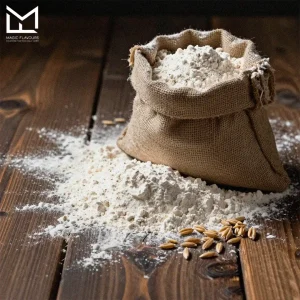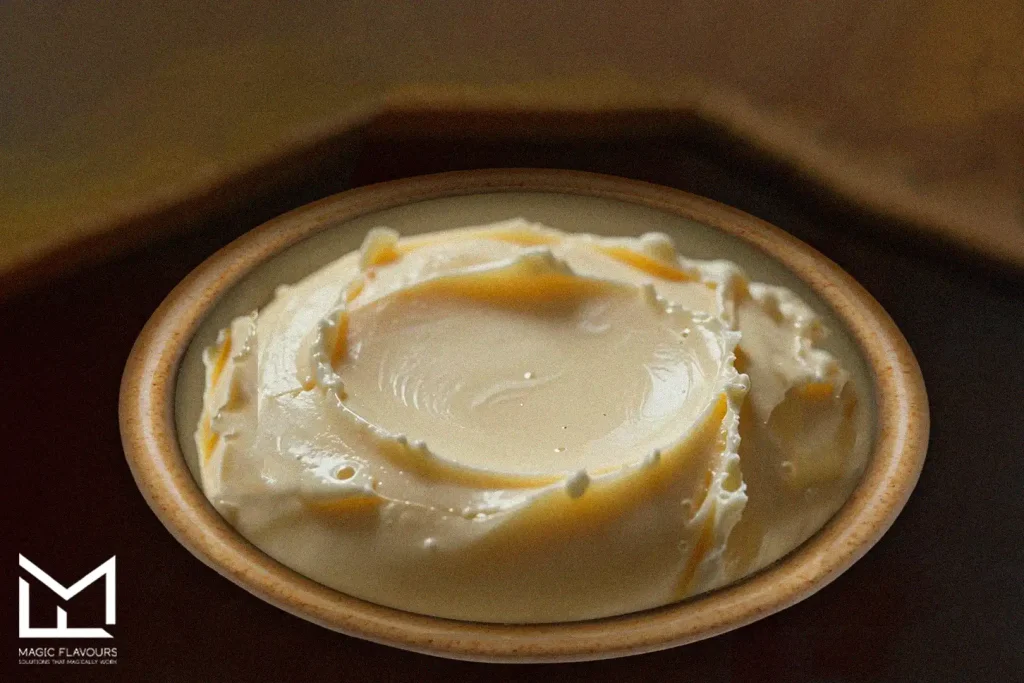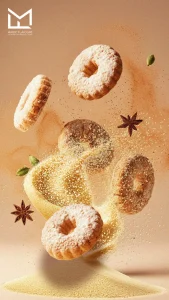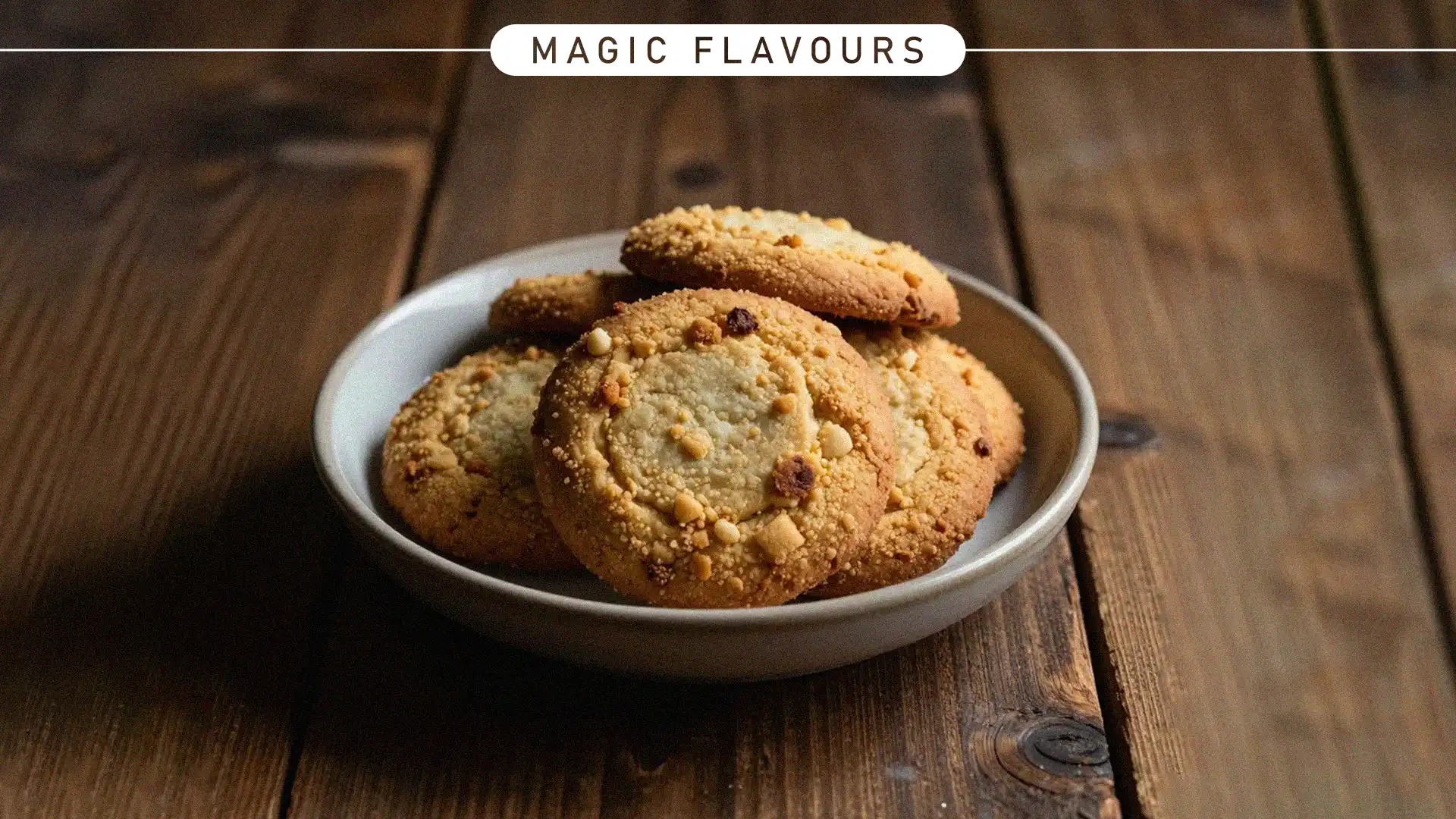1. Introduction to Biscuit Flavor
What Defines a Biscuit Flavor?
Biscuits are baked goods made from flour, fat, and a leavening agent. They vary widely across cultures. In the U.S., biscuits are soft and flaky. In the U.K., biscuits are crisp and sweet. Despite differences, all biscuits share a common base: flour, fat, and flavor.
Texture plays a key role in defining biscuits. Some are crumbly and tender, while others are crunchy and firm. The baking method influences this texture. For example, folding dough creates layers. On the other hand, rolling it flat gives a uniform crunch.
Flavor also helps define a biscuit. Ingredients like butter, sugar, and spices shape the taste. Even small changes in recipe affect the final flavor. Therefore, understanding biscuit flavor begins with knowing what a biscuit is.
Why Flavor Matters in Biscuits
Flavor drives consumer preference. People choose biscuits based on taste first. Texture and appearance come second. A biscuit with bland flavor rarely satisfies. On the contrary, a flavorful biscuit creates lasting enjoyment.
Flavor also reflects quality. Fresh ingredients produce richer taste. Artificial additives often dull the flavor. Because of this, bakers focus on natural components. They aim to balance sweetness, saltiness, and richness.
Moreover, flavor evokes emotion. A buttery biscuit may remind someone of childhood. A spiced one might feel festive. These emotional connections make flavor essential. Without it, biscuits lose their charm and identity.
Overview of Biscuit Types and Their Flavor Profiles
Biscuits come in many forms. Each type offers a unique flavor. For example, shortbread is rich and buttery. Digestives are mildly sweet with a wheaty taste. Crackers lean toward savory and salty.
Sweet biscuits often include vanilla, chocolate, or fruit. These flavors appeal to dessert lovers. Meanwhile, savory biscuits use cheese, herbs, or spices. They pair well with soups or spreads.
Regional styles also influence flavor. American biscuits are soft and buttery, while British biscuits are crisp and sweet. In contrast, Asian biscuits may include sesame or matcha. Altogether, each type reflects local taste preferences and traditions.
2. Ingredients and Their Impact on Biscuit Flavor
Flour Types and Their Flavor Contributions

Flour forms the base of every biscuit, and its type directly affects the flavor. For example, wheat flour gives a mild, nutty taste. In contrast, whole wheat adds earthiness and depth. Meanwhile, rye flour introduces a slightly sour, robust flavor. Each flour brings unique notes.
Protein content also matters. High-protein flours create chewy textures. Low-protein flours yield tender, delicate biscuits. Texture influences flavor perception. Moreover, flour freshness impacts taste. Fresh flour tastes clean. Old flour may taste stale or bitter.
Alternative flours offer new flavors. Almond flour adds sweetness and nuttiness. Oat flour gives a soft, creamy taste. These flours also change texture. Therefore, choosing the right flour shapes both flavor and mouthfeel.
Role of Fats of Biscuit Flavor: Butter, Oil, and Alternatives
Fats carry flavor and affect texture. Butter adds richness and depth. It also enhances browning, which boosts flavor. Oil gives a lighter taste. It creates a softer, more tender biscuit. Each fat changes the flavor profile.
Margarine mimics butter but lacks complexity. Coconut oil adds a sweet, tropical note. Shortening gives a neutral base. Choosing the right fat depends on the desired flavor. Butter suits savory and sweet biscuits. Oil suits lighter styles.
Fat also affects aroma. Butter releases strong, pleasant smells during baking. These aromas influence flavor perception. In contrast, neutral fats allow other ingredients to shine. Therefore, fat choice is crucial for flavor balance.
Biscuit Flavor Sweeteners: Sugar, Honey, Stevia, and Inulin
Sweeteners define biscuit sweetness. Sugar gives clean, direct sweetness. It also aids browning and crispness. Honey adds floral notes and moisture. It creates a softer texture and deeper flavor.
Stevia offers sweetness without calories. However, it may taste bitter or metallic. Inulin adds mild sweetness and fiber. It also improves texture. These alternatives suit health-focused biscuits. But they change flavor complexity.
Sweeteners interact with other ingredients. Sugar balances salt and fat. Honey pairs well with spices. Choosing the right sweetener shapes both taste and texture. Therefore, it must match the biscuit’s purpose.
Leavening Agents and Their Flavor Effects
Leavening agents create rise and texture. Baking powder gives a neutral lift. Baking soda adds a slight bitterness. Yeast introduces complex, fermented flavors. It suits savory or artisanal biscuits.
Chemical leaveners affect browning. Baking soda enhances Maillard reactions. This deepens flavor and color. Yeast also adds aroma. Its fermentation creates rich, bread-like notes.
Leavening choice changes mouthfeel. Airy biscuits taste lighter. Dense ones feel richer. Flavor depends on both rise and reaction. Therefore, leavening agents shape more than just texture.
Biscuit Flavor Salt and Spices: Enhancing and Balancing Taste
Salt enhances all flavors. It sharpens sweetness and balances bitterness. Without salt, biscuits taste flat. Even small amounts make a big difference. Salt also affects dough structure.
Spices add character to biscuits. For instance, cinnamon gives warmth, nutmeg adds depth, and cardamom introduces floral notes. Meanwhile, savory spices like paprika or cumin create bold flavors. Altogether, each spice changes the biscuit’s identity.
However, combining spices requires care. Too much overwhelms, while too little fades. Therefore, balance is key. Salt and spice must complement other ingredients, and together, they elevate the biscuit’s flavor complexity.
Biscuit Flavor Add-ins: Nuts, Fruits, Chocolate, and Herbs
Add-ins personalize flavor. Nuts add crunch and richness. Almonds taste sweet. Walnuts give bitterness. Fruits bring sweetness and acidity. Dried berries add chewiness and tang.
Chocolate adds indulgence. Dark chocolate gives depth. Milk chocolate adds creaminess. Herbs like rosemary or thyme add freshness. They suit savory biscuits best.
Add-ins must match the base flavor. Too many clash. Just enough enhances. Texture also matters. Crunchy nuts contrast soft dough. Juicy fruits soften the bite. Therefore, add-ins must be chosen with care.
3. Flavor Chemistry in Biscuit Baking
Maillard Reaction and Caramelization
The Maillard reaction creates complex flavors. It happens when proteins and sugars heat together. This reaction forms golden crusts and rich aromas. Caramelization also adds depth. It occurs when sugars break down under heat. Together, these reactions define biscuit flavor.
Time and temperature control these reactions. Higher heat speeds browning. Longer baking deepens flavor. However, too much heat burns the biscuit. Therefore, bakers must balance time and temperature carefully.
Different sugars affect the outcome. Glucose browns quickly. Sucrose caramelizes slowly. Choosing the right sugar helps control flavor. That’s why recipe design matters.
Aroma Compound Formation
Aroma compounds shape flavor perception. They form during baking through chemical reactions. Maillard reactions and fat breakdown release these compounds. Each one adds a distinct scent.
Vanillin gives a sweet, creamy aroma. Pyrazines add roasted notes. Aldehydes bring fruity or nutty tones. These compounds rise with steam and reach the nose. That’s how aroma enhances taste.
Ingredient freshness affects aroma. Old flour or rancid fat dulls the scent. Therefore, fresh ingredients ensure vibrant biscuit flavor.
Fat–Aroma Interactions of Biscuit Flavor

Fats trap aroma compounds. They hold them during baking and release them slowly. Butter, for example, binds and enhances sweet and savory notes.
Different fats interact differently. Saturated fats hold aroma longer. Unsaturated fats release it faster. This affects how flavor unfolds while eating.
Fat also influences mouthfeel. Creamy texture boosts flavor perception. Therefore, fat choice impacts both aroma and taste.
Sugar Form and Sweetness Perception of Biscuit Flavor
Sugar type changes sweetness. Granulated sugar gives clean sweetness. Brown sugar adds molasses notes. Powdered sugar dissolves quickly and tastes lighter.
Liquid sugars like honey or syrup add moisture. They also deepen flavor. Each sugar affects texture and browning differently.
Sweetness perception depends on balance. Salt sharpens sweetness. Fat softens it. Therefore, sugar must match the biscuit’s overall flavor profile.
Texture–Flavor Relationship
Texture affects how flavor is experienced. Crisp biscuits release flavor quickly. Soft ones hold it longer. Chewy texture allows slow flavor release. Crunchy texture gives instant impact.
Moisture level changes texture. Dry biscuits snap. Moist ones bend. This changes how aroma and taste reach the senses.
Texture also influences satisfaction. A flaky biscuit feels rich. A dense one feels hearty. Therefore, texture and flavor must work together.
4. Sensory Evaluation of Biscuit Flavor
Methods of Sensory Testing
Sensory testing helps evaluate biscuit flavor. Experts use trained panels or consumer groups. Each method reveals different insights. Trained panels detect subtle differences. Consumers reflect real-world preferences.
Testing includes blind tasting, scoring, and descriptive analysis. Tasters rate sweetness, saltiness, and aroma. They also describe texture and aftertaste. These details guide product improvement.
Consistency matters in testing. Samples must be uniform. Testing conditions must stay controlled. Without consistency, results lose reliability. Therefore, proper setup ensures accurate flavor evaluation.
Flavor vs. Aroma vs. Texture
Flavor combines taste, aroma, and texture. Taste includes sweet, salty, sour, bitter, and umami. Aroma adds depth and complexity. Texture affects how flavor is released.
Aroma reaches the nose before tasting. It shapes expectations. Texture influences mouthfeel and satisfaction. Crunchy biscuits feel bold. Soft ones feel comforting.
Each element interacts. A rich aroma enhances sweetness. A smooth texture softens bitterness. Understanding these layers helps create balanced biscuit flavor.
Crossmodal Interactions in Biscuit Flavor Perception
Crossmodal interactions link senses. Sight, smell, and touch affect taste. For example, golden color suggests sweetness. Crunchy sound boosts flavor intensity.
Smell and taste work together. Aroma compounds trigger flavor memories. Texture changes how flavors unfold. A crisp bite releases aroma faster.
Even packaging influences perception. Bright colors suggest sweetness. Earth tones hint at natural flavors. Therefore, flavor is not isolated. It’s shaped by multiple sensory cues.
Psychological and Emotional Influences of Biscuit Flavor on Taste
Taste connects to emotion. Familiar flavors evoke comfort. New ones spark curiosity. Childhood memories often shape biscuit preferences.
Mood affects flavor perception. Happy people rate flavors higher. Stress may dull taste. Even music or lighting changes how biscuits taste.
Branding also plays a role. A trusted brand feels tastier. Nostalgic packaging boosts enjoyment. Therefore, flavor is not just physical. It’s emotional and psychological too.
5. Cultural and Regional Biscuit Flavor Variations
Southern-Style Biscuits vs. British Biscuits
Southern-style biscuits are soft, flaky, and buttery. They often use buttermilk, which adds tang and richness. These biscuits pair well with savory dishes like gravy or fried chicken. Their flavor is mild but comforting.
British biscuits are crisp and sweet. They resemble cookies more than bread. Digestives and shortbread are popular examples. Sugar and butter dominate the flavor. Some include oats or spices for added depth.
The texture difference shapes flavor perception. Southern biscuits melt in the mouth. British biscuits crunch and linger. Each style reflects its culinary roots. Therefore, flavor depends on both tradition and technique.
Asian Biscuit Flavors (e.g., Matcha, Sesame)
Asian biscuits often feature unique ingredients. Matcha adds earthy bitterness and vibrant color. Sesame gives a nutty, roasted taste. These flavors reflect local preferences for subtle sweetness and depth.
Rice flour is common in Asian biscuits. It creates a light, crisp texture. This allows delicate flavors to shine. Some biscuits include red bean or taro for sweetness. These ingredients add cultural identity.
Packaging also influences flavor perception. Asian biscuits often look elegant and minimal. This sets expectations for refined taste. Therefore, flavor is shaped by both ingredients and presentation.
European Traditions (e.g., Speculoos, Digestives)
European biscuits offer rich, spiced flavors. For example, speculoos includes cinnamon, nutmeg, and cloves, creating a warm and festive taste. In contrast, digestives are milder, with a wheaty, slightly sweet profile, and often pair beautifully with tea or cheese.
Butter plays a key role in European biscuits, adding richness and aroma. Additionally, some recipes use brown sugar or golden syrup, which deepen flavor and enhance browning.
Texture also varies across Europe. Italian biscotti are hard and crunchy, while French sablés are tender and crumbly. Ultimately, each biscuit reflects regional taste and tradition, with flavor following form and heritage.
Middle Eastern and Mediterranean Biscuit Notes

Middle Eastern biscuits often include spices and nuts. For example, cardamom, cinnamon, and anise are common, while pistachios and almonds add richness and crunch. Together, these flavors create a warm and aromatic experience.
Similarly, Mediterranean biscuits use olive oil and citrus. Lemon zest adds brightness, and orange blossom water gives floral notes. In many recipes, honey replaces sugar, adding depth and natural sweetness.
Texture also varies, ranging from crisp to chewy. Some biscuits include semolina for a grainy bite, while others use ground nuts for softness. Ultimately, these biscuits reflect ancient traditions, with flavors that tell stories of culture and celebration.
6. Innovations and Trends in Biscuit Flavor
Health-Conscious Formulations
Health-conscious biscuits focus on reducing sugar, fat, and calories. Bakers use natural sweeteners like stevia or fruit puree. These ingredients lower sugar while keeping flavor intact.
Whole grains and fiber-rich flours replace refined ones. This adds texture and earthy notes. Consumers prefer biscuits that taste good and feel healthy. Therefore, flavor must balance nutrition and satisfaction.
Low-fat recipes use yogurt or applesauce. These add moisture and mild sweetness. Flavor remains key, even in healthy options. Without it, biscuits lose appeal.
Plant-Based and Gluten-Free Flavor Challenges
Plant-based biscuits avoid dairy and eggs, which changes both texture and flavor. For example, coconut oil or nut butter often replaces butter. As a result, these ingredients add distinct—and sometimes overpowering—notes.
Gluten-free flours like rice or almond affect taste. They lack the neutral flavor of wheat. Bakers must blend flours to balance flavor and structure.
Binding agents like flaxseed or chia add earthy tones. Some consumers enjoy this. Others find it unfamiliar. Therefore, flavor development requires careful testing and adjustment.
Fortified Biscuits for Nutrition and Flavor
Fortified biscuits include added vitamins, minerals, or protein, and these ingredients often affect taste. For example, iron may taste metallic, while protein powders can feel chalky. Therefore, flavor masking becomes essential.
Natural flavors like vanilla or cocoa help cover off-notes. Sweet spices also improve taste. Bakers use layering to hide nutrients behind familiar flavors.
Texture plays a role too. Crunchy biscuits distract from unusual flavors. Soft ones may highlight them. Therefore, fortification must consider both flavor and mouthfeel.
Experimental Flavor Pairings and Fusion Biscuits
Fusion biscuits mix global flavors. Matcha with white chocolate. Chili with dark cocoa. These combinations surprise and delight adventurous eaters.
Savory-sweet blends are trending. For example, cheese with honey or rosemary with lemon create complex, layered flavor experiences. In addition, cultural inspiration drives innovation. Mediterranean herbs meet Asian spices, and fusion biscuits reflect both global tastes and modern creativity. Therefore, flavor boundaries continue to expand.
7. Consumer Preferences and Market Insights of Biscuit Flavor
Biscuit Flavor Trends in Global Markets
Global markets show diverse flavor preferences. For example, in Asia, matcha and black sesame are popular, while in Europe, butter and spice dominate. Meanwhile, North America favors sweet and salty combinations. Overall, these trends reflect cultural tastes and eating habits.
Seasonal flavors also drive demand. Pumpkin spice rises in autumn. Citrus flavors peak in summer. Limited editions boost excitement and sales. Therefore, timing matters in flavor strategy.
Health trends influence flavor too. As a result, consumers seek natural, clean-label ingredients and prefer real fruit with less sugar. Therefore, flavor innovation must balance novelty and familiarity. In this way, brands stay competitive.
Emotional and Nostalgic Flavor Appeal
Flavor connects to memory. For example, a buttery biscuit may remind someone of childhood, while a spiced one may evoke holidays. These emotional links, in turn, drive loyalty and repeat purchases.
Nostalgic flavors often return as limited editions. For instance, brands revive old recipes or classic packaging, which creates both excitement and comfort. In this way, consumers feel connected to the past.
Emotion also shapes perception. A familiar flavor feels richer. A comforting aroma enhances taste. Therefore, emotional appeal is a powerful tool in flavor design.
Packaging and Flavor Perception
Packaging influences flavor expectations. Bright colors suggest sweetness. Earth tones hint at natural ingredients. Texture and shape also matter. A sleek box feels premium. A rustic wrap feels homemade.
Labels guide perception, since words like “buttery” or “crunchy” set mental cues. In addition, images of ingredients reinforce flavor ideas. Ultimately, consumers taste with their eyes first.
Scented packaging adds another layer. Some brands use aroma to boost appeal. Therefore, packaging must align with flavor to create a full sensory experience.
Flavor Testing in Product Development
Flavor testing ensures both quality and appeal. For this reason, brands use blind tastings, focus groups, and expert panels. Each method, in turn, reveals different insights. While consumers show clear preferences, experts are able to detect subtle flaws.
Testing happens in stages. Early trials explore concepts. Later tests refine recipes. Feedback shapes final flavor decisions. Without testing, products risk failure.
Data also guides development. Sales trends and reviews highlight what works. Therefore, successful biscuits blend science, creativity, and consumer input. In this way, flavor evolves.
8. Conclusion of Biscuit Flavor
Summary of Key Flavor Drivers
Biscuit flavor depends on ingredients, baking chemistry, and texture. To begin with, flour, fat, and sweeteners shape the base taste. Then, spices, salt, and add-ins build complexity. In the end, each choice affects the final flavor.
Baking reactions like Maillard and caramelization deepen the taste. In addition, aroma compounds enhance flavor perception. At the same time, texture controls how flavor unfolds. For example, crisp biscuits release flavor quickly, while soft ones hold it longer.
Cultural traditions and consumer preferences also guide flavor. Regional styles reflect local tastes. Emotional connections influence enjoyment. Therefore, flavor is both technical and personal.
Future Directions in Biscuit Flavor Innovation
Flavor innovation is evolving fast. Health trends are pushing for natural ingredients and reduced sugar. At the same time, plant-based and gluten-free options are growing in popularity. As a result, these shifts require new flavor strategies.
Technology helps refine flavor, and today AI and data guide product development. In addition, sensory testing ensures both quality and consumer appeal. At the same time, fusion flavors and global inspiration expand possibilities. Ultimately, bakers mix tradition with creativity to craft something unique.
Sustainability also matters. Consumers want ethical ingredients and clean labels. Flavor must adapt to these values. Therefore, innovation must balance taste, health, and ethics.
Final Thoughts on Crafting the Perfect Biscuit Flavor
Crafting perfect flavor takes skill and care. To achieve this, bakers must balance ingredients, texture, and aroma. Beyond that, they also need to consider culture, emotion, and market trends. Ultimately, every detail matters.
Flavor is more than taste. It’s experience, memory, and satisfaction. A great biscuit delights all senses. It feels familiar yet fresh. It comforts and surprises.
Success comes from testing and refinement. Moreover, listening to consumers helps shape better products. In the end, perfect flavor is a journey—not a formula, because it evolves with every bite.
